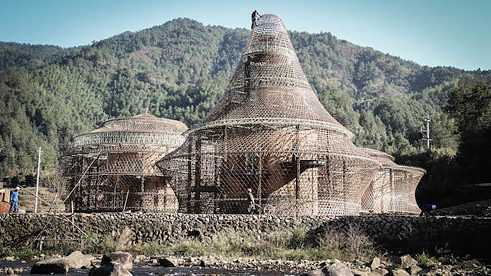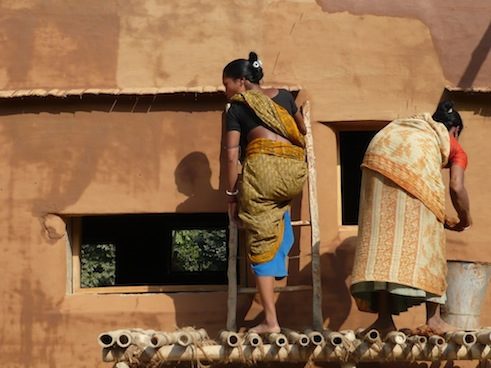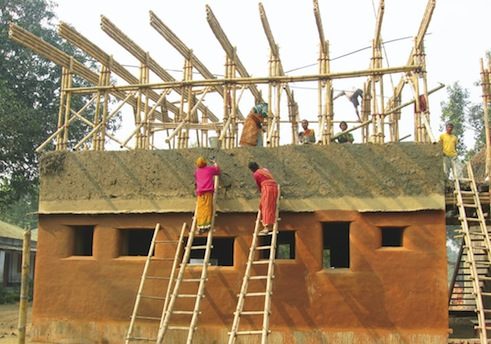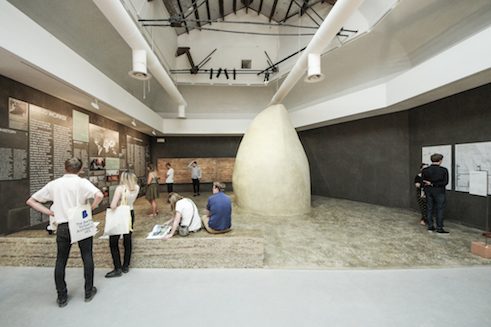Sustainable Construction
On the beauty of adobe

For her thesis project, together with Eike Roswag, architect Anna Heringer realised the Meti School in Rudrapur, Bangladesh – an adobe building. For this she was honoured with numerous international architecture awards, among them the Aga Khan Award for Architecture 2007. At the 2016 Architecture Biennale in Venice, together with Martin Rauch und Andres Lepik, Heringer, an expert in sustainable construction, set up a sculpture made of adobe. In addition to her work as an architect, Anna Heringer currently teaches design as a guest professor at the Technical University of Munich.
Frau Heringer, you are known for your statement: “For me, sustainability is a synonym for beauty.” What precisely do you mean by that?
True beauty is only possible when the process, the entire cycle of a building is fair, good, indeed sustainable. The design, the materials used, techniques and construction have to be in harmony with the location of the building, its surroundings and the needs of its users: for me, that is what constitutes its aesthetic and sustainable value.
 DESI Trainingcenter, Rudrapur, Bangladesh
| © Kurt Hoerbst
DESI Trainingcenter, Rudrapur, Bangladesh
| © Kurt Hoerbst
Can you describe this principle on the basis of one of your current projects?
In 2016 we shall complete three hostels in Baoxi, a village about 600 km south of Shanghai. The hostels are made of bamboo and stamped adobe, fantastic regional building materials. In terms of design I also draw on local traditions, in this case basketry. The hostels are large sculptural objects. We use the resources and the potentials of the people in Baoxi, because one needs a great deal of labour power and skilled craftspeople for bamboo and adobe. In this way, not only does a personal connection with the new buildings arise, the economic profit stays local. This contributes to social and economic justice.
Developing architecture from local resources and thereby creating buildings that meet high aesthetic and social standards: does that work in industrialised countries as well?
Yes! Building with natural materials such as wood, bamboo, adobe or stone with human labour power is possible everywhere. That does not mean we have to go back to the Stone Age. One can build very contemporary, healthy and beautiful houses with adobe. This is demonstrated, for instance, by the herb centre of the lozenge manufacturer Ricola by Herzog & de Meuron in Switzerland, a stamped-adobe building, or the Haus Rauch in Vorarlberg in Austria, an apartment building made entirely of natural materials. In Paris there are plans for an adobe high-rise. Perhaps the building of the German Embassy in Georgia will also be built of adobe; that is under discussion. Modernity is not a question of the materials, but of the design capability of responding to the needs of society.
Why do you think it is important to use natural materials?
It is impossible to build buildings of steel and concrete for seven billion people on the earth, since the resources of our planet are limited and there is no reason why someone in Germany should use more of them than, for example, in Bangladesh. This is why natural building materials are crucial for sustainable development. Adobe is available almost everywhere, can be recycled endlessly and was a common building material around the world for centuries. Today, it is hardly used any more in industrial countries. This ought to change, since adobe buildings save resources, enable more diversity in architecture –and create meaningful work, especially for many less-qualified people whose jobs have been lost through digitalisation.
 DESI Trainingcenter, Rudrapur, Bangladesh
| © Kurt Hoerbst
DESI Trainingcenter, Rudrapur, Bangladesh
| © Kurt Hoerbst
What has to happen so that more good adobe architecture can emerge?
We need more research and investment in adobe construction and innovative owners who assist in anchoring this construction material that is available almost everywhere in contemporary architecture. After all, the point here isn’t nostalgia, but instead to link up and further develop traditional building materials with today’s know-how.
Together with Martin Rauch and Andres Lepik, you have set up an adobe sculpture at the 2016 Architecture Biennale in Venice. What have your experiences been like?
For this project we processed 25 tonnes of adobe from Venice, and it is fascinating to see how visitors react. Lots of them say, “How peaceful,” when they emerge from the enterable sculpture and have directly experienced the aura, stability and archaic power of this material. Many people today no longer have any access to the earth, at most in the form of a flower pot on the windowsill. Adobe creates a very good and healthy indoor climate, adobe regulates humidity and has a beneficial effect on our state of mind.
 Mud Works, Venice Biennale
| Stefano Mori
Mud Works, Venice Biennale
| Stefano Mori
I am convinced that more adobe buildings would significantly improve the quality of life in our hectic cities. I would like to introduce my experience with sustainable construction in Bangladesh, China and Zimbabwe into Europe as well. And incidentally, one needn’t always build new. Enhancing old building substance in my homeland of Bavaria with adobe: now that’s where I can imagine any number of interesting projects.
Exhibition “Think Global – Build Social”
The exhibition Think Global, Build Social! – Architectures for a Better World explores the theme of social responsibility in contemporary architecture. Conceived jointly by the Architekturzentrum Wien and the Deutsches Architekturmuseum. The touring exhibition can be seen at Goethe-Institutes worldwide:
2016
- August–September: Johannesburg, Santiago
- October–December: Ouagadougou, Lima/Montevideo
2017
- January–February: Kinshasa, Caracas
- March–April: Addis Abeba, Buenos Aires
- May: Amman
- June–July: St. Petersburg
- September: Sofia
- October–November: Helsinki